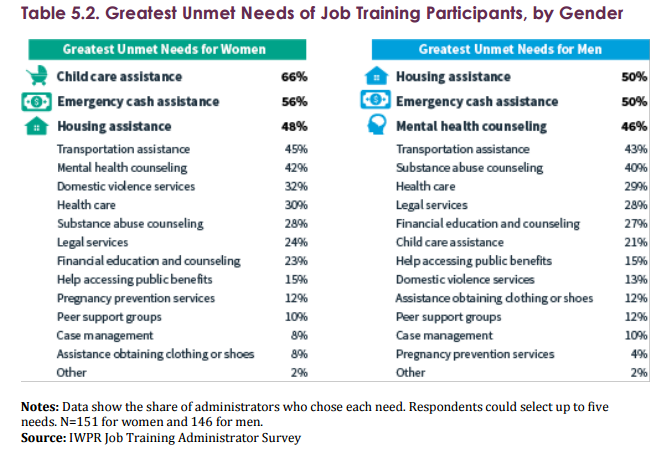IWPR recently released findings from a survey of job training administrators. Below are some insights from administrators captured in the survey. Read the full report, Supportive Services in Workforce Development Programs: Administrator Perspectives on Availability and Unmet Needs at iwpr.org and read the press release with key findings, “Job Training and Community College Administrators Say Supportive Services are Key to Program Completion, but are Not Adequately Funded.”
Ninety-seven percent of administrators say supportive services are important or very important for job training retention or completion. One survey respondent from a trade association wrote,
“Supportive services are critical. All of the training and job placement efforts in the world aren’t going to be effective if the trainee can’t get to/from work, doesn’t have child care resources, or can’t overcome other barriers to getting and keeping the job.”
Another individual from a community college said,
“[Supportive services] are essential for us, a community college serving a diverse student body. The primary obstacles our students face are child care, transportation, and earning enough to cover their living expenses. These concerns take precedence over their academic coursework when the student is struggling to address them, and they negatively impact student retention at our institution.”
Administrators identify financial considerations and child care as the most common reasons job training participants do not complete training.

One administrator said,
“Child care is the biggest challenge for students. By providing an on-campus option where students can drop off and pick up their dependent children, the college has alleviated that barrier for several of my students who otherwise couldn’t take their full-time schedule and graduate on time. This child care opportunity is a huge component to the students’ success.”
Another said,
“We have multiple mothers who credit the child care offered during classes as the reason they are able to attend. Without child care they would have to stay home and take care of their children as opposed to coming in and learning new skills.”
Program completion is higher in programs of shorter duration and in those that report that their participants’ supportive service needs are well met. One administrator spoke of the difference supportive services made for a job training participant,
“We had one young man who walked to his first job, which was 12 miles from his place of living! When he confided…this and suggested to his case manager he didn’t know how long he could continue, the case manager…began by providing a bus pass for one month, then secured a bicycle as a short-term solution. The participant was also enrolled in a financial education course, with a goal of saving towards a vehicle that could be efficient and affordable. He obtained a vehicle in time to avoid the winters.”
Yet, programs lack the resources to provide all the services their participants need. Administrators identify child care assistance as the greatest unmet need for women in job training programs, and housing and emergency cash assistance as the greatest unmet needs for men.

Administrators say that lack of funding is the greatest challenge to providing more supportive services. Faced with limited resources of their own, many establish partnerships with other organizations that provide the services their job training participants need. One respondent notes,
“Because we have long-standing partnerships with a wide range of local social service providers, we are often able to connect students easily with the assistance they need outside of our organization. This has helped countless individuals on their path to economic self-sufficiency and empowerment.”
By continuing to build and strengthen partnerships, organizations can improve access to supportive services among job training participants. Other possible strategies for ensuring that participants’ needs are met include striving to increase supports that represent participants’ greatest unmet needs, including the experiences and viewpoints of program leaders in making the case for increased public funding for supportive services, and encouraging the use of funds from underutilized sources such as the Supplemental Nutrition Assistance Program Employment & Training for supportive services.
To read the full report, visit iwpr.org.

